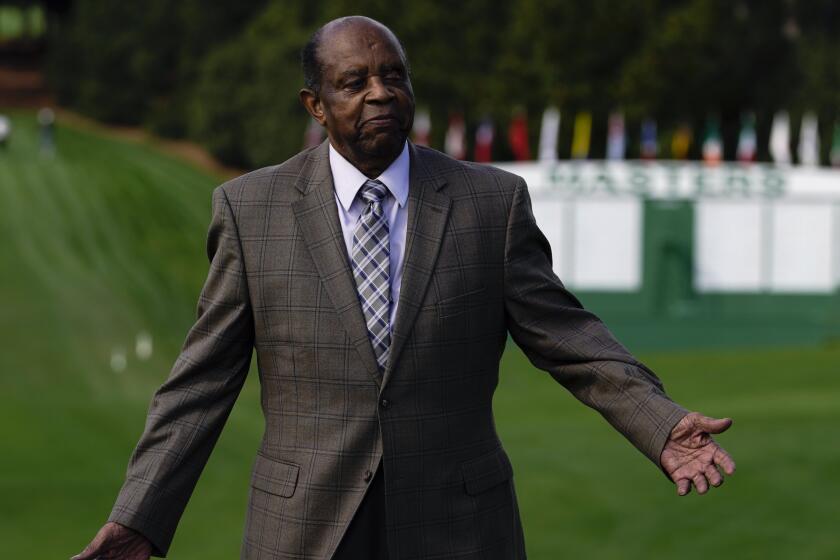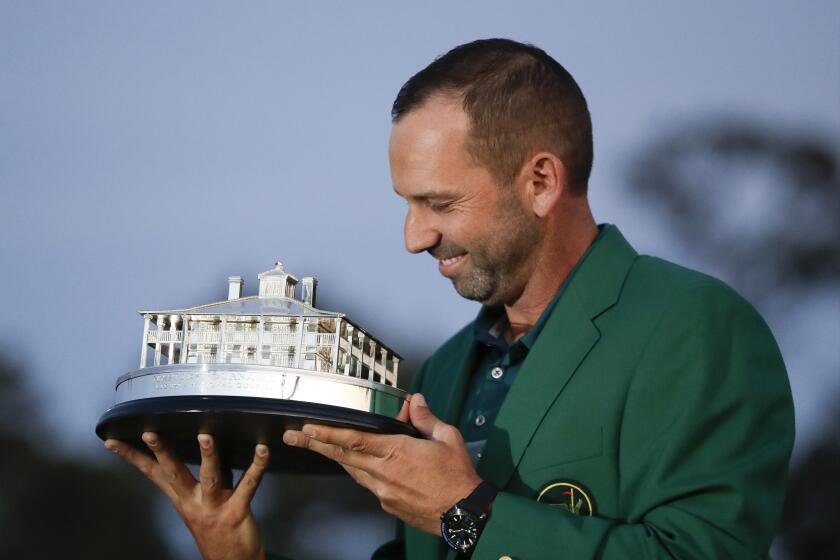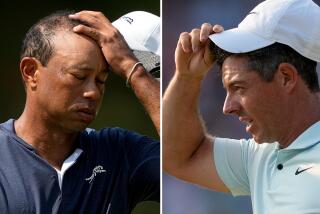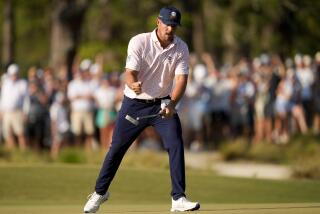Bryson DeChambeau brings his long game to the Masters
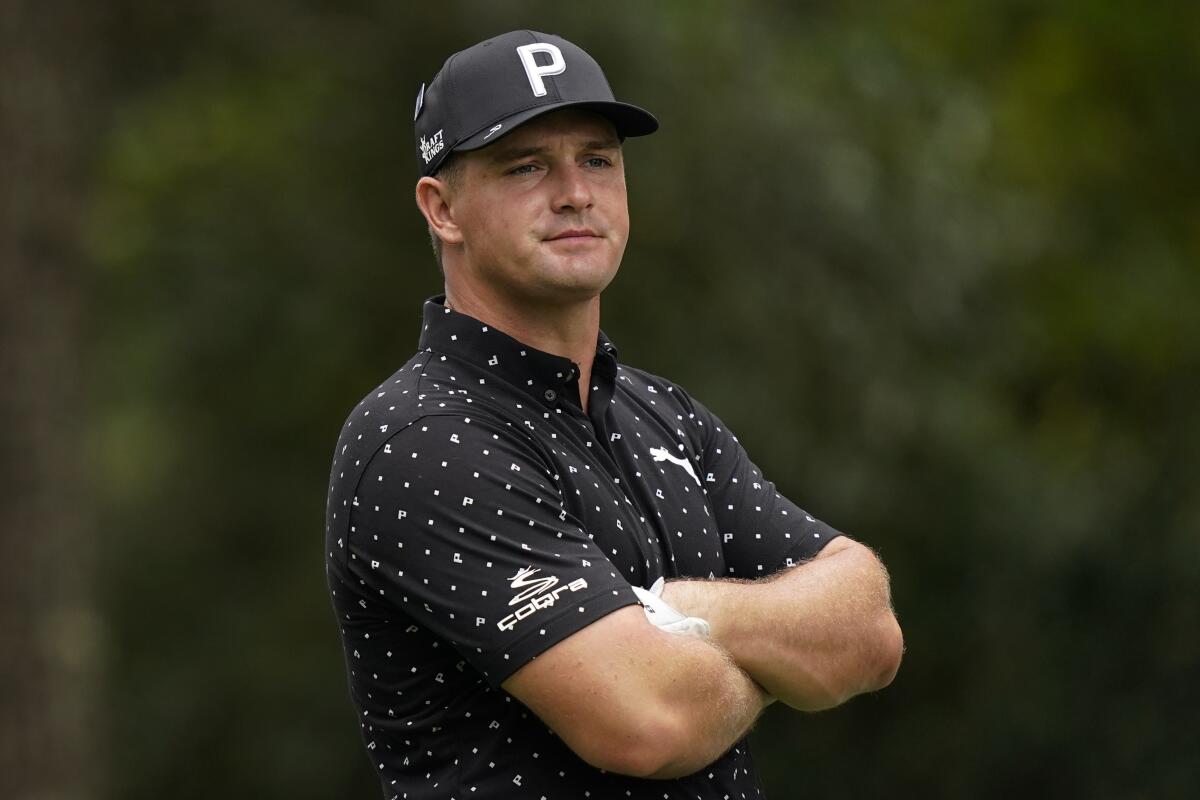
- Share via
AUGUSTA, Ga. — He’s dedicated. He’s innovative. He’s transforming the game of golf.
When he addresses a teed-up ball, Bryson DeChambeau thinks inside the box.
“From a driving perspective, I just am trying to get up there like I’m in a batter’s box, swinging as hard as I can trying to hit a home run,” DeChambeau said Tuesday during a break from preparations for the Masters. “I don’t know if there’s a better way to say it.”
The bulked-up DeChambeau is an open yardage book. In a sport filled with secret strategies and proprietary training methods, he’s transparent about this: He wants to use his strength and tremendous distance to bring Augusta National to its knees.
“Every day I’m trying to get faster and stronger and hit it as far as possible,” said the 235-pound DeChambeau, 27, who packed on 40 pounds over the past year with an intense weightlifting regimen. “I have no idea where the end game is on this. I’ve only seen improvements in strength increase. … I will say that I’m hitting it further now than I was at Shriners [last month], and I am hitting it further than the U.S. Open [in September.], and I’m trying a driver this week that may help me hit it a little bit further, so we’ll see. Still up in the air.”
His drives too might still be up in the air. DeChambeau, who won that U.S. Open at Winged Foot by six strokes, is obliterating the ball. His average drive is PGA Tour-leading 344.4 yards, 52.8 yards longer than his 2019 average.
Augusta National recognizes Lee Elder and will endow two scholarships at a historically Black college in his name and cover its golf programs’ costs.
He is the talk of the Masters, even when defending champion Tiger Woods is vying for his sixth green jacket and Augusta National is staging its storied tournament in the autumn for the first time, and without spectators.
“He’s put in the time,” Woods said of DeChambeau. “He’s put in the work. What he’s done in the gym has been incredible and what he’s done on the range and what he’s done with his entire team to be able to optimize that one club and transform his game and the ability to hit the ball as far as he has and in as short a span as he has, it’s never been done before.”
Two decades ago, much was made of the “Tiger-proofing” of Augusta, which added length to 10 holes during the period when Woods won four major championships in a row, including consecutive Masters, and thoroughly dominated the game.
Woods worked out with legendary dedication, but not with the specific goal of driving the golf ball from Augusta into South Carolina. He already had all the length he needed.
“As I got bigger and I filled out and tried to get stronger, it was to not hit the ball further,” he said. “It was to be more consistent and to be able to practice longer.”
DeChambeau is unapologetic about wanting to squash the ball like a marshmallow, yet he holds his specific workout information close to the weighted vest.
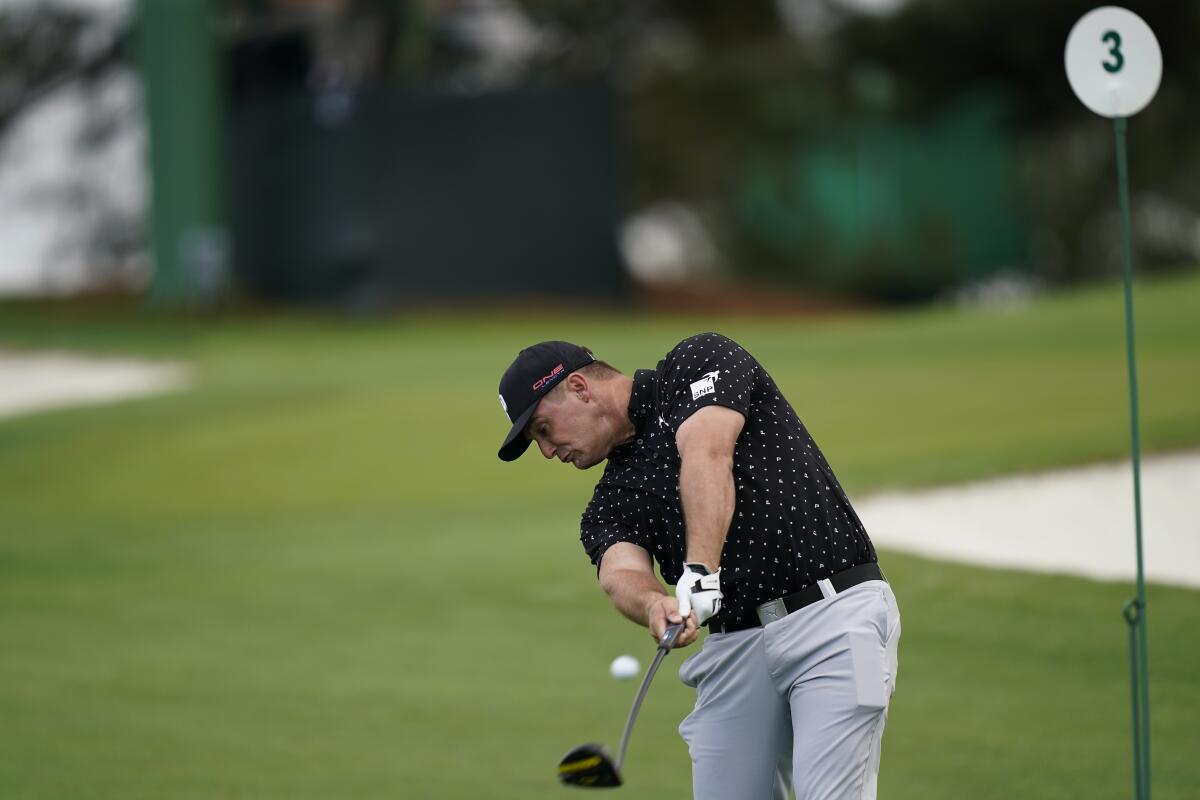
“There’s a lot behind the scenes that I do that is kept proprietary that I don’t talk about,” he said. “All the things that are on the surface are totally achievable for anybody, but take a massive amount of time to do, and it’s very difficult to do.
“It’s not just about getting stronger in the gym. It’s about doing it in a way that enhances your body, not breaks it down. You have to still learn how to swing the golf club at a faster pace, and you have to learn how to move it in a way that allows you to be comfortable with that and not hurt yourself. And you have to learn how to hit it straight.”
DeChambeau is experimenting this week with a 47½-inch driver, which is almost three inches longer than the average driver on tour, and a half-inch less than the maximum allowable length. A longer club shaft means more clubhead speed, and that translates into longer shots.
“I tested it [Monday] for the first time, and I’ve gone through at least three or four iterations of the shaft, and this is the most promising one yet,” he said. “I had about a 4-5 mph in ball speed increase. … It looks really promising right now. I did not expect it to work. I’m not 100% sure if I will put it in play yet just because of the unknown; it’s so close to the Masters. But if it’s an improvement of every facet of launch conditions, I don’t see why not.”
Three-time Masters winner Phil Mickelson sees the game trending in that direction.
“A good friend of mine who I have a lot of respect for has an opinion, and I agree with it — that ultimately, it might be five years, 10 years, 15 years, but every driver will be standard at 48 inches,” Mickelson said. “And then you’ll have kind of a weak driver, kind of a two-wood, if you will, which is kind of what I’ve gone to now.”
Sergio Garcia pulled out of the Masters on Monday after he tested positive for the coronavirus, becoming the second player to withdraw following a positive test.
Mickelson called DeChambeau “a huge asset to the game of golf” because of the attention he’s attracted from around the sports world.
“He has worked hard to create the strength and also the speed, and that’s not easy to do,” Mickelson said.
“I’ve had a chance to see how hard he works in other areas, whether it’s brainwaves and his mental and cognitive function or what he eats. … I mean, the guy has made some massive changes that has required a lot of work and scrutiny, and he’s putting himself out there and doing it.”
DeChambeau conceded that in moving forward — himself, and perhaps the game — he’s going to fail more often than he succeeds.
“I think people are starting to understand that it’s not just about me being quirky and doing things in my own way,” he said, “but it’s about the process of trying to be better every day.
“If I go down a road and it doesn’t work, I’ll pull myself back out and try something else.”
More to Read
Go beyond the scoreboard
Get the latest on L.A.'s teams in the daily Sports Report newsletter.
You may occasionally receive promotional content from the Los Angeles Times.

